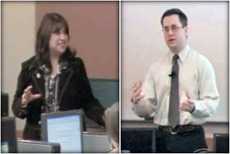What is Case-Based Library Instruction?: Difference between revisions
No edit summary |
No edit summary |
||
| (6 intermediate revisions by the same user not shown) | |||
| Line 8: | Line 8: | ||
Attendee satisfaction ratings for clinic content average almost 5% higher for clinics taught using the case method, and an independent samples t-test shows that this increase is statistically significant at a 95% confidence level. Anecdotal evidence has also been encouraging, with both students and faculty specifically commenting on the value added by the case method. We continue to research the impact of case teaching and will add citations for our findings as they are published. | Attendee satisfaction ratings for clinic content average almost 5% higher for clinics taught using the case method, and an independent samples t-test shows that this increase is statistically significant at a 95% confidence level. Anecdotal evidence has also been encouraging, with both students and faculty specifically commenting on the value added by the case method. We continue to research the impact of case teaching and will add citations for our findings as they are published. | ||
For further discussion of the origin and implementation of the Business Research Clinics and the introduction of case teaching, see | For further discussion of the origin and implementation of the Business Research Clinics and the introduction of case teaching, see: | ||
Andy and Leticia | *Andy Spackman and Leticia Camacho, "Integrated, Embedded, and Case-Based: Selling Library Instruction to the Business School," in ''Librarian as Architect: Planning, Building and Renewing: Thirty-Sixth National LOEX Library Instruction Conference Proceedings'', edited by Brad Sietz, Susann deVries, Sarah Fabian, Suzanne Gray, & Robert Stevens (forthcoming from Ypsilanti, MI: LOEX Press, 2009). You can view the slides from the associated presentation [http://www.loexconference.org/2008/presentations/SpackmanCamachoLOEX08.pdf here]. | ||
* Andy and Leticia also presented at the KLA/MPLA joint conference in Wichita, Kansas, April 2, 2009, "Case-Based: Selling Instruction to the Business School". Slides for this presentation can be viewed here: [[Media:Mpla09.pdf]] | |||
* Andy Spackman and Leticia Camacho, "Rendering Information Literacy Relevant: A Case-Based Pedagogy," ''The Journal of Academic Librarianship'' 35, no. 6 (2009): 548-554. ([http://dx.doi.org/10.1016/j.acalib.2009.08.005 Published version], [http://hdl.lib.byu.edu/1877/2114 Pre-print version]) | |||
== Concept == | |||
Teaching with cases is widespread in legal, business, and medical fields, and has been shown to increase both learning and enthusiasm in students. Case teaching is a problem-based approach to active learning, concepts that are increasing prominent in the library field. (See the [[Annotated Bibliography]] for further reading.) | |||
The purpose of case teaching as practiced in business schools is to immerse students in a complex situation in which they can apply the tools they have acquired. Unfortunately, typical business school case studies do not provide a good pattern for library instruction because they are self-contained (i.e., they include all pertinent information), and students are often prohibited from looking at outside information sources. | |||
Case-based library instruction inverts this model. The case itself consists of a brief problem statement built around a narrative structure. This storytelling element captures student interest and accentuates the inductive and constructivist nature of learning through cases. The focus is on identifying what kinds of information would meet the needs of the case and exploring library and Internet resources to obtain such information. The objective is not to teach students how to conduct an analysis (that’s their professors’ job), but how to gather and assess the information they would need for an analysis. | |||
Teaching with cases requires significant additional preparation on the part of the librarian. While the case itself may be simple, the librarian must create a scenario that students find compelling, that leads naturally to discussions about principles of information literacy, and that will highlight the resources the librarian wishes to introduce. To achieve this, the librarian needs to be familiar with the information needs students regularly encounter in their coursework and which they may anticipate in their future careers. Furthermore, because case studies allow students greater freedom in their problem solving, the flow of an instruction session may take unexpected turns, which requires librarians to spend much more time researching the scenario prior to an instruction session than the students will spend researching during the instruction session. Such intense preparation may increase the temptation to show students the laundry list of everything library has to offer, but the instructor must resist this tendency. | |||
== Case Teaching and Information Literacy == | |||
The case teaching method allows principles of information literacy, as defined by the Association of College and Research Libraries’ ''Information Literacy Competency Standards for Higher Education''[http://www.ala.org/ala/mgrps/divs/acrl/standards/informationliteracycompetency.cfm], to be introduced naturally. | |||
# After explaining the premise of the case, librarians should lead a preliminary discussion in which students "[determine] the nature and extent of the information needed" (Standard One). | |||
# Through a sequence of demonstrations and exercises, students gain experience "[accessing] needed information effectively and efficiently" (Standard Two). | |||
# This interactive process provides opportunities for the librarian to help students "[evaluate] information and its sources critically" in the context of scenarios they might face in their future careers (Standard Three). | |||
# The problem-based nature of case studies makes it possible for one-time library instruction sessions to achieve Standard Four: "The information literate student . . . [uses] information effectively to accomplish a specific purpose," and this outcome can be demonstrated by requiring students to present their findings to their peers. | |||
# Students often raise questions related to copyright, licensing restrictions, and access after graduation during the preliminary discussion or the wrap-up, allowing the librarian to address the ethical, legal, and socio-economic issues revolving around information use (Standard Five). | |||
==[[About the Library Instruction Case Wiki]]== | ==[[About the Library Instruction Case Wiki]]== | ||
Latest revision as of 10:57, 18 December 2009
Origins
Andy Spackman and Leticia Camacho began experimenting with case teaching at Brigham Young University's Marriott School of Management in September 2007. Without a physical presence in the business school we spend much of our effort on outreach, for which library instruction has proven most effective. By 2007 we were conducting over 120 instructional sessions per year, with over 3,000 participants. These sessions were primarily integrated into specific courses, including a mandatory session in the communications class required of all business school students. And yet students continued to express a need for additional opportunities for formal library instruction in specific topics. To meet this need we launched a series of extracurricular, open-door clinics modeled after the clinics at The Home Depot stores. (See a schedule of recent clinics here.)
These "Business Research Clinics" have been a success, with 637 students and faculty attending 48 clinics during the first two years. Our approach evolves as we learn more about promoting library instruction where attendance is voluntary, and based on early student feedback we began to use cases in our teaching. The case method is familiar to business students who commonly encounter it in their regular coursework. Adapting this pedagogical model to library instruction has made us much more effective in connecting with our students and faculty and makes principles of information literacy more relevant to them.
Attendee satisfaction ratings for clinic content average almost 5% higher for clinics taught using the case method, and an independent samples t-test shows that this increase is statistically significant at a 95% confidence level. Anecdotal evidence has also been encouraging, with both students and faculty specifically commenting on the value added by the case method. We continue to research the impact of case teaching and will add citations for our findings as they are published.
For further discussion of the origin and implementation of the Business Research Clinics and the introduction of case teaching, see:
- Andy Spackman and Leticia Camacho, "Integrated, Embedded, and Case-Based: Selling Library Instruction to the Business School," in Librarian as Architect: Planning, Building and Renewing: Thirty-Sixth National LOEX Library Instruction Conference Proceedings, edited by Brad Sietz, Susann deVries, Sarah Fabian, Suzanne Gray, & Robert Stevens (forthcoming from Ypsilanti, MI: LOEX Press, 2009). You can view the slides from the associated presentation here.
- Andy and Leticia also presented at the KLA/MPLA joint conference in Wichita, Kansas, April 2, 2009, "Case-Based: Selling Instruction to the Business School". Slides for this presentation can be viewed here: Media:Mpla09.pdf
- Andy Spackman and Leticia Camacho, "Rendering Information Literacy Relevant: A Case-Based Pedagogy," The Journal of Academic Librarianship 35, no. 6 (2009): 548-554. (Published version, Pre-print version)
Concept
Teaching with cases is widespread in legal, business, and medical fields, and has been shown to increase both learning and enthusiasm in students. Case teaching is a problem-based approach to active learning, concepts that are increasing prominent in the library field. (See the Annotated Bibliography for further reading.)
The purpose of case teaching as practiced in business schools is to immerse students in a complex situation in which they can apply the tools they have acquired. Unfortunately, typical business school case studies do not provide a good pattern for library instruction because they are self-contained (i.e., they include all pertinent information), and students are often prohibited from looking at outside information sources.
Case-based library instruction inverts this model. The case itself consists of a brief problem statement built around a narrative structure. This storytelling element captures student interest and accentuates the inductive and constructivist nature of learning through cases. The focus is on identifying what kinds of information would meet the needs of the case and exploring library and Internet resources to obtain such information. The objective is not to teach students how to conduct an analysis (that’s their professors’ job), but how to gather and assess the information they would need for an analysis.
Teaching with cases requires significant additional preparation on the part of the librarian. While the case itself may be simple, the librarian must create a scenario that students find compelling, that leads naturally to discussions about principles of information literacy, and that will highlight the resources the librarian wishes to introduce. To achieve this, the librarian needs to be familiar with the information needs students regularly encounter in their coursework and which they may anticipate in their future careers. Furthermore, because case studies allow students greater freedom in their problem solving, the flow of an instruction session may take unexpected turns, which requires librarians to spend much more time researching the scenario prior to an instruction session than the students will spend researching during the instruction session. Such intense preparation may increase the temptation to show students the laundry list of everything library has to offer, but the instructor must resist this tendency.
Case Teaching and Information Literacy
The case teaching method allows principles of information literacy, as defined by the Association of College and Research Libraries’ Information Literacy Competency Standards for Higher Education[1], to be introduced naturally.
- After explaining the premise of the case, librarians should lead a preliminary discussion in which students "[determine] the nature and extent of the information needed" (Standard One).
- Through a sequence of demonstrations and exercises, students gain experience "[accessing] needed information effectively and efficiently" (Standard Two).
- This interactive process provides opportunities for the librarian to help students "[evaluate] information and its sources critically" in the context of scenarios they might face in their future careers (Standard Three).
- The problem-based nature of case studies makes it possible for one-time library instruction sessions to achieve Standard Four: "The information literate student . . . [uses] information effectively to accomplish a specific purpose," and this outcome can be demonstrated by requiring students to present their findings to their peers.
- Students often raise questions related to copyright, licensing restrictions, and access after graduation during the preliminary discussion or the wrap-up, allowing the librarian to address the ethical, legal, and socio-economic issues revolving around information use (Standard Five).

